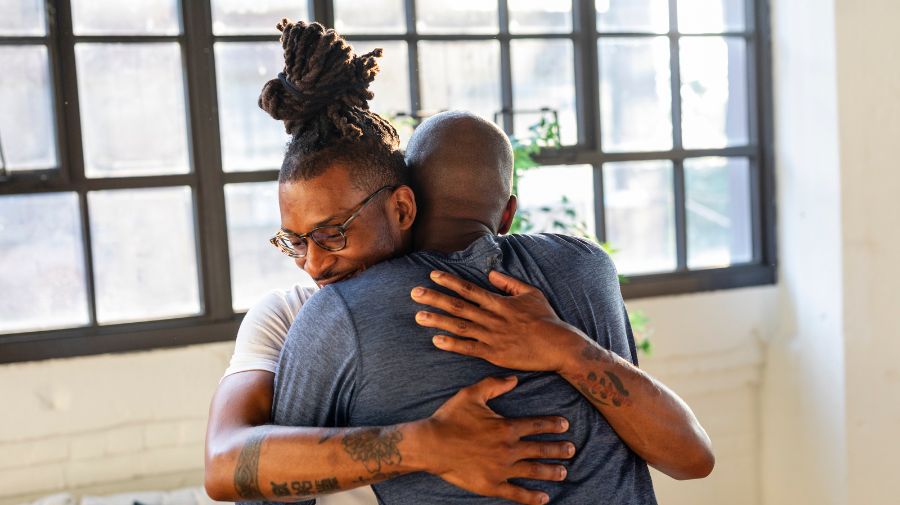By Justin Steinman, CMO
I saw a superhero movie last weekend about mental health.
As someone who has seen probably 60 superhero movies in his lifetime, that’s a sentence that I never thought I would write.
Last Saturday, I took my three sons to go see Thunderbolts*, the latest movie from the Marvel Cinematic Universe (MCU). If you haven’t seen it yet, you may want to stop reading here, because I can’t discuss the mental health angle without getting a little spoiler-y. (If you’re looking for a movie review, this blog isn’t a review, but I will say that I’d give the movie 4 stars out of 5.)
The Thunderbolts* (yes, the asterisk is part the title) assembles a bunch of second- and third-tier superheroes into a kind of anti-hero team to battle a super-powered individual suffering what can only be described as bipolar disorder. This individual (named Bob) has both a superhero side (complete with gold-colored suit) called Sentry and a villain side (completely black shadows) called Void. The Void’s superpower? It’s not super-strength or laser beams from his eyes. All the Void can do is lock you inside your worst memory and force you to relive it over and over again.
When he is neither Sentry nor the Void, Bob is just Bob. He talks repeatedly about getting lost inside himself, being unable to control his sad side, and we learn that he witnessed violence between his parents when he was a child. The climax of the movie is not a large battle on the streets of New York or any other city, but rather takes place inside Bob’s mind as his two personalities fight for control of his one body. The topic of mental health was treated seriously and the “dark side” of Bob’s bipolar disorder (exacerbated by his drug abuse) is the root of his evil actions.
“In the best way possible, Thunderbolts* normalizes mental health – as a discussion topic, as a movie theme, even as a defining character attribute in a movie that cost $200 million to make.”
Justin Steinman, CMO
What’s remarkable to me about this movie is that I don’t think it could have been made ten, or even five, years ago. Mental health was just something that we did not talk about … we might whisper about it, and if you had a mental illness in a movie, you were likely described as “crazy” if people were being mean or “different” if people were being polite. The Marvel creative team deserves kudos for dealing with mental health in a mature and realistic way, yet still making it accessible enough that my three teenage boys understood what was going on and why mental health is important.
The mental health discussion isn’t just limited to the movie’s villain. The hero (and arguably biggest star in the movie) is clinically depressed. The movie opens with a scene of Yelena Belova, aka the Black Widow, jumping off the top of a building in Malaysia, while she shares via a voiceover, “I’m not focused, and I’m not happy, and I don’t have purpose.” When was the last time that you heard a superhero talk about their internal feelings and lack of purpose. Historically, our superheroes have been one-dimensional paragons of good without much emotional depth. Not in the Thunderbolts*. Yelena is worn out by her life as an assassin and looking for deeper meaning and connection. Much of the movie’s plot is driven by Yelena’s attempt to connect with people – her estranged father, her would-be teammates, and ultimately Bob as she tries to bring him back to his good side. In fact, all of the members of the team are facing their own internal mental health demons as they search for purpose and the best versions of themselves.
In the best way possible, Thunderbolts* normalizes mental health – as a discussion topic, as a movie theme, even as a defining character attribute in a movie that cost $200 million to make. Every character in the movie is dealing with their own mental health issues, and it’s only by overcoming their mental challenge – not physical challenges – that the Thunderbolts are able to save the day. (It’s a comic book movie, after all, so you know that the heroes will ultimately win.)
On the way home from the movie, I found myself talking with my kids about the symptoms of bipolar disorder, why Yelena struggled to connect with people, and why it’s ok sometimes to not be ok. Not your typical Saturday afternoon conversation, but one that I’m glad that we had.
Now if I could just figure out how to fly like Superman ….
This is the first entry in an ongoing series of occasional blog posts from Justin Steinman that will cover topics at the intersection of mental health, pop culture, and current events. The opinions expressed in this blog are entirely Justin’s and do not necessarily reflect the opinions of Ensora Health or any of its employees. Reach out to Justin with your comments at justin.steinman@ensorahealth.com.






